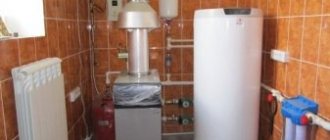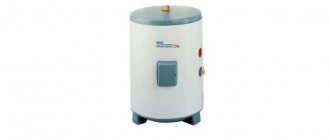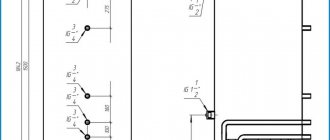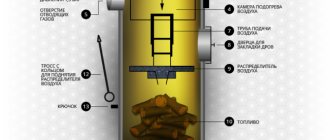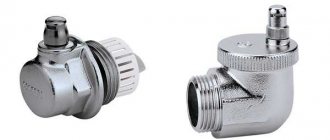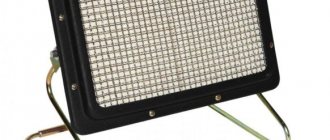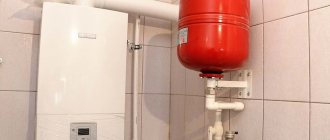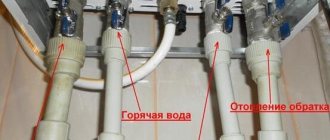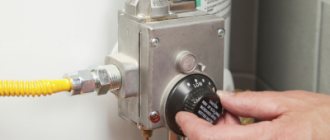SHARE ON SOCIAL NETWORKS
FacebookTwitterOkGoogle+PinterestVk
It is difficult to imagine comfortable living conditions without hot water. But there are many complaints about the work of the water supply. In apartments in multi-storey buildings in large cities, hot water is often supplied intermittently. In this case, an indirect heating boiler will help out: the operating principle of this unit is quite simple, and it is possible to create it even with your own hands. But it must be said right away: that such equipment requires connection to the heating system.
An indirect heating boiler allows you to save on electricity by using the coolant of the heating system
What is an indirect heating boiler and why is it needed?
A boiler is usually called a heater or tank that supplies an apartment or house with hot water. In general, there are 2 types of such units: direct and indirect heating. The main difference between the latest version of the water heater is that this boiler emits heat produced by the heating system. The appearance of the indirect heating tank evokes an association with a barrel. But on the modern market you can find models that have the shape of a cube or parallelepiped. The first, being made with an indirect heating boiler in the same style, are usually installed directly under it. This solution saves space in the utility room.
The indirect heating boiler can be connected to both a gas and electric boiler
Indirect heating boiler: operating principle
Water is supplied to the unit on 2 circuits. The first is a heating one, which is connected to the heating system of the living space. In the second, the water coming from the water supply system is heated and subsequently distributed to water intake points.
Heating circuits are implemented in the unit under consideration using two methods:
- "tank in tank" From the name it is clear that this is an indirect heating boiler, the design of which provides for the formation of a circuit by placing a smaller steel container in the main tank;
- a coil is mounted in the main tank.
Connection diagram for an indirect heating boiler
Both circuits are connected in parallel to the home heating system. The coolant flows from it into the boiler through a pipeline. To organize efficient coolant circulation, such a pipeline must be equipped with a pumping and mixing system.
Helpful advice! When purchasing a boiler for a gas boiler, evaluate the power of the latest unit. It should be enough to ensure simultaneous operation of the heating system and the boiler turned on for heating.
Cold water is supplied to the heating tank, and hot water is taken away by consumers. It should be borne in mind that many manufacturers produce such an indirect heating boiler with several heat exchangers. This design works more efficiently, but is extremely rare on sale.
Pros and cons of an indirect hot water boiler
The advantages of the technical solution implemented by this device include:
- during the heating season, the wiring is not overloaded, since the device does not operate from the mains;
- both the coolant and the internal heater system do not come into contact with tap water. It follows that such an indirect heating boiler will last a long time;
- hot water will begin to flow into the tap immediately after starting the unit, because its operation is based on the recirculation process;
Diagram of the design of an indirect heating boiler
- A well-designed water heating system based on this device will work efficiently at the optimal level of costs at the operating stage.
But there are some drawbacks here. Of these, experts highlight:
- installation of an indirect heating boiler with recirculation requires significant preparatory work, requiring considerable financial expenses, which will negatively affect the family budget;
- a boiler of this type costs much more than its electric or gas counterparts;
- It takes about 1-2 hours to initially heat the water. During this period of time, the quality of the heating system may noticeably deteriorate;
- Having purchased a 100-liter indirect heating boiler at an affordable price, you will have to allocate a separate room for its installation. The fact is that even with a seemingly not so large volume of internal capacity, the external dimensions of such a device are very impressive. Not to mention the 200-liter indirect heating boiler. But the industry even produces 300-liter samples;
One of the disadvantages of using an indirect heating boiler is the possibility of reducing the efficiency of the heating system
- The supply of hot water to your home depends on whether the heating system is currently running. But for obvious reasons, there is no need for it in the summer. There are two ways out of this situation: installation of an individual coolant supply system that serves only the boiler, or installation of a combined indirect heating boiler with an electric heating element.
Let's look at the last option in a little more detail. The most inexpensive and for this reason the one that has become traditional in a boiler is a copper heating element. However, due to the intensive formation of scale at high temperatures in hard water, it quickly fails. In addition, these deposits reduce the degree of heat transfer from the heating element, resulting in increased energy consumption.
Helpful advice! Purchasing a combined indirect heating boiler with a “dry” heating element will allow you to save on electricity bills.
Connecting an indirect heating boiler is an intervention in the heating and water supply systems, so before deciding to purchase a device, you should consult with specialists
This electric heating element is made of ceramic. And they called the heating element “dry” because it is enclosed in a steel flask. That is, there is no direct contact with water, and, accordingly, scale does not form. The presence of such a frame leads to an increase in the heat transfer area and a decrease in the cooling intensity. That is why less electricity is required to operate a combined heating boiler with a “dry” heating element.
Common installation mistakes
During installation or during the commissioning process, you should try to avoid a number of mistakes:
- The boiler and boiler are installed far from each other. Their installation should not only be done as close to each other as possible. But, to simplify installation, the pipes are positioned correctly.
- Incorrect connection of the pipeline with the coolant.
- Incorrect installation of the circulation pump.
Proper installation, adjustment and configuration guarantee a stable hot water supply and allow all systems and devices to operate normally. This will prevent wear of parts and save on premature repairs.
Connecting a storage boiler to a gas boiler
You can heat water in the unit in question using a gas or solid fuel boiler, solar water heater or heat pump. Moreover, its operation is possible in conjunction with two types of heating equipment: single- and double-circuit.
According to the standard wiring diagram for an indirect heating boiler, it is connected to the heating system, as well as to the hot and cold water supply branches. In this case, cold water comes from below, hot water is removed from the container located on top of the tank, but the recirculation point is located in the middle of the boiler. The direction of movement of the heated coolant is the opposite - from top to bottom. That is, from the gas boiler it enters the water heater pipe located at the top, and returns to the heating pipeline through the lower pipe of the unit.
The principle of operation and connection of an indirect heating boiler to the boiler
Thanks to this connection scheme for an indirect heating boiler, the efficiency of this device increases. After all, heat is first transferred to the heated layers of water.
Features of connecting an indirect heating boiler to a double-circuit boiler
In order for the boiler to work successfully in tandem with a heating unit that has a hot water supply circuit, a three-way valve is used. It distributes the coolant flow between the additional water supply circuit and the main heating circuit.
A thermostat is installed in the indirect heating storage boiler. It is he who generates control signals for the three-way valve. When the temperature of the water in the tank drops below a certain level, the valve, upon command from the thermostat, will turn on and redirect the flow to the hot water supply branch from the heating pipeline. Signals from the thermostat will return the valve to its original state if the water temperature in the heater exceeds a preset point. The coolant flow is directed into the heating pipeline.
When connecting an indirect heating boiler, you must make sure that all communications are possible and also purchase the necessary pressure sensors
During the warm season, the unit works differently: the flow is not redirected, but the combustion modes of the gas boiler are controlled. When the temperature of the water in the boiler decreases, the thermostat transmits a corresponding signal to the three-way valve. Based on this “command,” the last device “ignites” the main burner of the heating unit. When the water temperature exceeds a certain value, the gas supply to the burner is stopped.
Important! When setting the maximum water temperature in the tank (also known as the temperature for automatic operation of the thermostat), the user should take into account that its value should be less than the value of this parameter set for the boiler automation.
The above scheme works most effectively when using gas boilers equipped with automation and a circulation pump. In this case, the heating unit itself can control the valve based on the signal received from the water heater thermostat. You should be aware that when operating a water heating system with a three-way valve, the priority of the heater circuit is higher than the heating circuit.
Connection diagram for an indirect heating boiler to a single-circuit boiler
To ensure effective joint operation of an indirect heating boiler with a single-circuit gas boiler, a circuit with two circulation pumps is used. A connection of this type can actually replace the above-described three-way valve circuit. Separation of coolant flows using pumps through different pipelines is the key feature of this type of connection. The distribution of circuit priorities is the same as in the previous case. However, higher priority of the water supply circuit over the heating circuit is ensured only through special settings of the pump activation algorithm.
Connection diagram for an indirect heating boiler to a single-circuit boiler
The alternating activation of the pumps is also controlled by signals from a thermostat installed in the tank. A check valve must be installed in front of each device. Creating such a piping for an indirect heating boiler prevents mixing of coolant flows.
This scheme works like this: turning on the DHW pump is accompanied by turning off the heating pump. That is, the heating system will begin to cool down. However, a noticeable decrease in the indoor temperature will not be observed for the reason that heating the water in an indirect heating boiler with a gas boiler will last a short period of time. The inhabitants of the house will feel this only during the initial start-up.
Sometimes, to create a large area of a building at a comfortable temperature, owners use several heating units. Then an additional pump is installed in the storage water heater piping.
Features of piping an indirect heating boiler with recirculation
If hot water is not drawn for a long period of time, it will begin to cool. It may take several minutes for the hot flow to reach the end consumer. Reducing the time for draining cooled water is ensured by using a piping scheme for an indirect heating boiler with recirculation. This is realized by organizing the forced movement of a heated flow through pipelines closed in a ring.
Connection diagram for a boiler with a recirculation system
Helpful advice! When choosing a piping scheme for heating and hot water circuits (with or without the possibility of recirculation), it is necessary to take into account the features of the heating system, as well as make accurate calculations of the equipment power and the level of demand for hot water.
The recirculation technical solution ensures almost instantaneous delivery of hot water to any connected plumbing fixture. It provides that another circuit, equipped with its own circulation pump, is installed in the indirect heating boiler piping, and additional structural components are installed:
- safety valve (designed to protect the water heating device from high pressure);
- automatic air vent (prevents the pump from airing);
- expansion tank (performs the function of compensating pressure in the DHW circuit when the taps are closed);
- check valve (prevents reverse water flow in the pipeline).
Related article:
Water boilers: review of the best offers on the modern market
Review of the best models and manufacturers. Types and rules for choosing a suitable water heater. Draining water from the boiler.
Subtleties of work
If, when searching for heating equipment for your own home or apartment, the choice is on a single-circuit boiler and you plan to connect a boiler to it, then you need to take into account the following features of the operation of the boiler in tandem with this heat exchanger.
- From the moment the boiler is turned on until the water in it is completely heated, the heating system will not work. Based on this problem, it is necessary to choose a hot water supply heat exchanger according to the maximum water heating time, which would be enough to prevent freezing of heating pipes in the extreme frost of the region where you live.
- Choose a boiler based on power, connecting it with the heated area of the premises, not forgetting about the climate zone of residence, what the house is built from and whether its walls have thermal insulation - all this is important when choosing the power of the heating unit.
- Having decided on the power, you can say with accuracy whether such a boiler will handle a boiler water heating system or not.
Heating specialists believe that a boiler installation can only function normally with a boiler with a power of at least 24 kW. Another expert figure is that the boiler takes up to 50% of the power from the boiler. These are the numbers you need to focus on when choosing a gas boiler model for your home. And avoid a situation where a 35 kW boiler is installed with an estimated heating power consumption of 25 kW, and the boiler takes 17 kW. As a result, a boiler power deficit of 7 kW is formed.
It is also worth noting the fact that in some cases a boiler with high performance is required, with a capacity of 200 or even 500 liters.
Such boilers are produced with built-in circulation pumps for domestic hot water.
Making your own indirect heating boiler
All work consists of assembling the components included in the design. As an example, let's take the manufacture of a water heater with a coil. The simple operating principle of this device inspires confidence that you can create such an indirect heating boiler yourself.
Design and connection diagram of a typical indirect heating boiler
Manufacturing and selection of a tank for a storage water heater
A boiler uses a tank as a container. The volume of this design component is a derivative of the hot water needs of the inhabitants of the house. This figure is calculated taking into account the fact that according to the standards, one family member per day should be about 50-70 liters. Thus, if a family consists of 4 people, you can opt for a 200-liter indirect heating boiler, the price of the components of which will not greatly burden the family budget.
However, it will not be possible to do without serious costs, since the tank for the heating device must be made of expensive aluminum alloys, expensive stainless steel or other corrosion-resistant material, the cost of which is also relatively high. A gas cylinder is also suitable as an alternative. However, its walls must first be cleaned and primed. Otherwise, the water will smell of gas.
5 holes are made in the tank: 1 at the bottom for connecting the drain tap, 1 more at the bottom for the inlet pipe, 1 at the top for water collection and 2 on the side for installing the coil. Knowing that this indirect heating boiler will have to be used at the end of the heating season, it is necessary to create conditions for installing the heating element by drilling a hole from below. After making the holes, attach ball valves or locking elements to them.
The volume of the boiler tank must be selected based on the number of people living in the house and points of water consumption
Coil manufacturing: materials and process description required
This element performs the function of a heating circuit in the storage boiler. That is, the coolant flows into it - hot water from the heating system. From contact with the heated surface of the coil, the temperature of the tap water present in the second circuit increases accordingly. A brass or copper tube is suitable for this component. Its length and diameter are determined by the volume of the tank. For 10 liters there should be an average of 1.5 kW of thermal power produced by the serpentine tube.
Helpful advice! To save money, you can use a metal-plastic tube or the same element made of another metal characterized by good heat transfer.
Wind the tube onto the cylindrical mandrel in a spiral. A large diameter pipe or log is suitable for this.
When winding the coil, you need to monitor the turns, adhering to the following recommendations:
- do not allow them to come into contact with each other. This will ensure better contact of the surface of the coil with the heated water;
- It is not recommended to use excessive force. Then it will not be easy to remove the coil from the mandrel;
- Correctly calculate the number of turns based on the height and volume of the tank.
Coil for indirect heating boiler, made of copper tube
Thermal insulation of the tank and installation of the finished structure
The outer surface of an indirect heating boiler of this modification must be covered with a heat-insulating layer. This technical solution will increase the efficiency of the unit and reduce heat losses. To insulate the container, use polyurethane foam, mineral wool or other heat-insulating material, which can be attached to the base with strip ties, glue or wire. To make the appearance of the tank attractive, it is better to cover its body with foil insulation or thin sheet metal.
It is also possible to create a prototype of a sandwich structure. This option involves installing the boiler being created in a tank of a larger diameter. The cavity formed between the surfaces can be filled with foam plastic or other heat-insulating material, thus forming a kind of thermos.
You can begin assembling the structure after preparing all the required parts and following the algorithm of actions:
- Mount the coil inside the tank along its walls or in the center. Solder the pipes to both the inlet and outlet pipes of the tank;
- decide how the heater will be installed. There are two options here. Typically, supports are welded to the bottom of floor-standing indirectly heated boilers. If you have chosen a wall-type indirect heating boiler, then solder, or better yet, weld the loops (or “ears”) to the back surface;
Modern indirect heating boilers are equipped with modern temperature control devices, as well as high-quality thermal insulation, which is difficult to replicate in DIY boilers
- install the heating element;
- close the boiler tightly with the lid;
- connect the coil to the heating system circuit. In this case, follow the standard rules for performing this procedure;
- connect the inlet and outlet water pipes;
- install a pipe to the bathroom or kitchen to the water intake point.
Heat accumulator for heating boilers: design features and connections
The purpose of using this unit is to collect and store coolant heated to a certain temperature for its further transfer to the system when the need arises. Being connected to the water circuit of the room, a battery of this type ensures temperature maintenance even if the heat source is turned off.
Helpful advice! If water heating of the house is produced from electricity, registration of a night tariff with reduced rates for the cost of 1 kW/h. will save you money on bills. It will be enough to heat the heating system at night, and the heat accumulator will work during the day.
The heat accumulator is used to maintain water heated to a certain temperature
This device also performs other functions. The main ones include:
- Reduces fuel consumption by almost a third. At the same time, the efficiency of the fuel installation increases;
- protects heating devices from overheating by collecting excess heat;
- heats water for the domestic hot water system. That is, in fact, this is one of the types of indirect heating boiler. The price of this unit varies within a very wide range: from 13 to more than 300 thousand rubles;
- the heat storage tank can connect several heat sources operating on different types of energy or fuel;
- The design of the device allows for the selection of coolant at different temperatures.
Design of a heat accumulator and rational connection of external devices
The main part of this unit is a cylindrical stainless tank filled with a liquid characterized by a high heat transfer coefficient. Its piping is carried out with heat-insulating material. In combination with the installation of a top jacket, this design solution increases the cooling time of the heat accumulator. Inside the cylindrical container there are 1 to 3 heat exchangers. The number of coils is determined by the capabilities and needs of the homeowners.
Heated water from solid fuel or gas boilers enters the cavity of the battery tank from above, and the cooled liquid settles closer to the bottom and is pumped back into the boiler for heating.
Diagram of a heat accumulator with the ability to connect to alternative energy sources
The lower compartment usually has a temperature of about 35-40°C. Therefore, it is advisable to connect it to a heated floor system. The temperature of the middle part is 60-65°C. Therefore, heating devices should be connected to it. The top of the tank is connected to the hot water supply. The water temperature there reaches 80-85°C.
Operating principle
The working circuit of the heating boiler is formed by the following elements:
- its own water heater (heat exchanger), located in the combustion chamber and heated by hot gas combustion products, which enters the furnace through the burner;
- a return pipeline supplying the boiler heat exchanger with cooled coolant (water) from the heating network;
- a direct pipeline of heated water leading from the heat exchanger to the heating system;
- a circulation pump that drives the coolant in a circle.
That's the whole concept diagram of the working cycle of a single-circuit boiler. Make-up (compensation for inevitable water losses) of the heating system of small boiler houses is usually carried out from the city water supply, which has a pressure in its pipelines higher than the pressure in the heating system.
The functional limitations of a single-circuit boiler, expressed in its use only for heating, is a significant disadvantage compared to its double-circuit “brother”.
But if the boiler is combined with an indirect heating boiler and thereby provides the consumer with hot water for domestic needs, then the capabilities of the boilers are equalized.
How to buy an indirect heating boiler: recommendations and popular models
When choosing a device to provide a certain object with hot water, its appearance should not be the main criterion. It is necessary to take into account the characteristics that directly affect the operating efficiency of this type of unit. This concerns, first of all, its volume. Moreover, peak loads on the water heating apparatus should be taken into account.
Experts recommend starting from the following values:
- for 1 person a volume of 50-60 liters will be enough;
- for 2-3 people you will need a boiler with a volume of 80-120 l;
- for 3-5 people, consider 120 - 200 liter models.
Modern manufacturers offer consumers a wide selection of indirect heating boilers of different sizes and shapes
Judging by the reviews, the most popular are the indirect heating boilers of the brands below.
Characteristics of the indirect heating boiler Protherm 200 liters Protherm B200S
The thermal insulation of this unit is made of polyurethane foam. The properties inherent in this material reduce heat loss to a minimum. The control panel provides an indication of the temperature of the water in the boiler. The titanium anode and enameled surface provide reliable protection of this water heater from corrosion and scale formation. The twin steel heat exchanger is located at the bottom of the unit. This allows you to significantly increase the supply of hot water and speed up the heating procedure.
Helpful advice! To achieve maximum operating efficiency of the Proterm indirect heating boiler of this model, operate it in combination with stationary type “Bear” and “Grizzly” boilers from the same manufacturer from Slovakia.
Below are the main technical characteristics of the Protherm B200S water heater:
| Volume, l | 200 |
| Form | Cylindrical |
| Type of allocation | Floor |
| Number of heat exchangers, pieces | 1 |
| Temperature regulator | Mechanical |
| Water temperature (maximum), °C | 90 |
| Daily energy losses, kW | 2 |
| Weight, kg | 90 |
Characteristics of the Drazice indirect heating boiler
If you want to buy a 200 liter indirect heating boiler for floor placement, it is recommended to consider the DRAZICE OKC 200 NTRR model from a manufacturer from the Czech Republic. This company has been producing similar equipment for more than 60 years, constantly improving its functionality and design.
The DRAZICE OKC 200 NTRR boiler model can be connected to both the heating system and the electrical network
The model range includes units that provide significant energy savings. The advantage is the relatively affordable price of an indirect heating boiler for 200 liters of Drazice - about 33 thousand rubles, and without compromising the high quality of work and long service life. Another plus concerns the question of how to connect the Drazice indirect heating boiler. There are two options here: to the heating system or to the electrical network.
Technical characteristics of the DRAZICE OKC 200 NTRR boiler:
| Volume, l | 200 |
| Form | Cylindrical |
| Type of allocation | Floor |
| Number of heat exchangers | 2 |
| Temperature regulator | Mechanical |
| Water temperature (maximum), °C | 110 |
| Weight, kg | 108 |
Technical characteristics of the ACV indirect heating boiler
A series of water heaters offered by the Belgian company ACV are durable, reliable, durable, spacious and modern units. To minimize the level of heat loss, the manufacturer paid great attention to thermal insulation. It is made of polyurethane foam - a completely environmentally friendly material, characterized by excellent noise-absorbing properties and a very long service life. The large tank capacity adds convenience to use. We are talking about the possibility of purchasing a 300-liter indirect heating boiler from this manufacturer.
Technical characteristics of the unit model ACV SMART SLE 300 are presented below:
| Total volume, l | 293 |
| Input thermal power, kW | 68 |
| Heating time to 80 °C, minutes | 22 |
| Productivity when heated to a temperature of 40 °C, liter/hour | 2100 |
| Empty boiler weight, kg | 87,0 |
The ACV SMART SLE 300 boiler is installed in a dry room with a temperature above zero. In this case, it is necessary to choose the right location for the water heater.
The SMART SLE 300 boiler model from ACV is equipped with high-quality thermal insulation, which reduces heat loss during operation
Helpful advice! During installation, it is necessary to reduce the length of utility lines as much as possible. So, in addition to saving money on the purchase of pipeline marking elements, you can further reduce the level of heat loss. That is, having already figured out how to connect an indirect heating boiler of this model, make sure that the distance from the points of hot water consumption from the unit is as small as possible.
Water heater Gorenje GBK80ORRNB6
If you are looking for a compact storage water heater model that can provide hot water to a house inhabited by 1-2 people, experts recommend paying attention to this product from the Slovenian manufacturer Gorenje.
The compact boiler GBK80ORRNB6 has two tubular heat exchangers. Its volume is enough to service two water intake points. The unit is equipped with an electronic control unit. The DHW temperature varies in the range of 15-75 °C.
The indirect heating boiler from the company GBK80ORRNB6 has a convenient control panel that allows you to control the water temperature
The function of an additional heater is performed by two “dry” heating elements. The model implements several types of protection: from heating without water and overheating, from corrosion (a magnesium anode is installed), from freezing (high-quality thermal insulation is implemented).
Another significant advantage of this unit is the presence of a function to control legionellosis (a common pulmonary disease, the habitat of which is hot water). In general, today this is one of the best solutions in terms of price and quality.
Technical characteristics of the Gorenje GBK80ORRNB6 water heater:
| Volume, l | 72,6 |
| A heating element | 2 coils |
| Accommodation option | Wall mounted |
| Water pressure (maximum), MPa | 0,6 |
| Weight, kg | 51 |
| Overall dimensions, mm | 507×500×803 |
Features of the Bosch SK 400-3 ZB water heater
The results of monitoring the modern market demonstrate the fact that the range of indirect heating boilers produced by the German concern Bosch contains a very limited number of items. Therefore, this model deserves special attention. It is distinguished by the simplicity of its design solution.
Bosch SK 400-3 ZB indirect heating boiler model and device connection diagram
The Bosch SK 400-3 ZB unit is an enamel-coated tank with a stainless steel coil. The use of a magnesium anode for protection against corrosion is also not surprising: this method of combating this phenomenon is used very often in equipment of this type. Ease of maintenance is ensured by a built-in thermometer and flange.
It is also possible to more precisely configure the operation of this water heater model by connecting recirculation of heated water and subsequent synchronization with the heating boiler. Thermal insulation is made of rigid foam rather than polyurethane foam, which, with equal thickness, does not provide such reliable protection against heat loss.
Technical characteristics of the Bosch SK 400-3 ZB unit:
| power, kWt | 60 |
| Volume, l | 388 |
| Productivity (maximum) in flow mode, l/min., ΔT=25°С | 24,2 |
| A heating element | 1 coil |
| Accommodation option | Floor |
| Water pressure (maximum), MPa | 1 |
| Weight, kg | 150 |
| dimensions | 710×1681 |
| Connecting the heating element | Impossible |
Features of the BOSCH WSTB 160 model
It is worth thinking about purchasing this water heater if a gas boiler is installed in your home. Although there is no possibility to connect a heating element here, the recirculation system functions.
The BOSCH WSTB 160 boiler has a laconic design, which is why it is very popular among consumers
This model is adapted for work in harsh operating conditions in the post-Soviet countries. In addition, the BOSCH WSTB 160 unit is suitable for working with hard water. To protect the steel from corrosion, the surface of the tank is coated with a glass-ceramic composition. To reduce heat loss, a polyurethane foam coat is used. The lining of the unit is soft, made of polyvinyl chloride. The connection type is frontal, it is possible to use a temperature sensor. The water is heated to a temperature of 45°C within 37 minutes.
Technical characteristics of the boiler of this model:
| power, kWt | 20,8 |
| Volume, l | 160 |
| Accommodation option | Wall |
| A heating element | 1 coil |
| Water pressure (maximum), MPa | 1 |
| Dimensions, mm | 1193×550 |
| Weight, kg | 42 |
Features of the Baxi indirect heating boiler
Often, owners of country houses choose a boiler, taking into account, first of all, the heating rate, and not its volume. In this case, you should take a closer look at the product from the BAXI GROUP holding (England) model Premier plus 300.
An indirect heating boiler from the Baxi company can be connected to any type of boiler
Helpful advice! If the material of manufacture of this unit - enameled steel or stainless steel - is critical for you, pay attention to its series. In the first case, it will be indicated by the sequence of characters “UB”, and in the second - “INOX”.
The key feature of this water heater is that the heat exchanger has a specific design - “coil within a coil”. And it should also be noted that the Baxi indirect heating boiler is compatible with boilers of any type. In addition, this unit is well protected from corrosion. The rather compact dimensions and light weight of this water heater did not become an obstacle to equipping it with an accurate thermal pump.
Another important advantage is the versatility of placement. The design of this model makes it possible to use a recirculation circuit. In addition, it is possible to connect a heating element (optimal power 2.7 kW).
Technical characteristics of the Premier plus 300 water heater model from BAXI:
| power, kWt | 30 |
| Volume, l | 300 |
| Heating element design | "coil within a coil" |
| Water pressure (maximum), MPa | 0,7 |
| Accommodation options | Floor and wall |
| Connecting the heating element | Maybe |
| Dimensions, mm | 2040×552 |
| Weight, kg | 60 |
Features of the indirect heating boiler Hajdu STA 400 C
This model may be of interest to a potential buyer due to the possibility of more precise settings in the presence of a heat exchanger. For example, at negative temperatures outside, this unit can be rebuilt to work together with a boiler, and in the summer, a connection to a solar collector can be organized (when necessary, a heating element is connected).
Some boiler models from Hajdu are equipped with a heat pump to maintain coolant circulation
The tank and heat exchanger are protected from corrosion by enamel and an installed magnesium anode. Polyurethane foam thermal insulation is protected, in turn, by a plastic casing. You can connect a DHW recirculation system.
Characteristics of the STA 400 C model:
| power, kWt | 69 |
| Volume, l | 400 |
| Productivity (maximum) in flow mode, l/min., ΔT=35°С | 28,3 |
| A heating element | 1 coil |
| Accommodation option | Floor |
| Ode pressure (maximum) | MPa 1 |
| Weight, kg | 145 |
| Dimensions, mm | 1832×670 |
In conclusion, it must be said that choosing and installing a combined boiler for a home is a responsible and complex task, which can be solved by reading the connection diagrams, advice and opinions of experts, as well as reviews from users of such systems.


